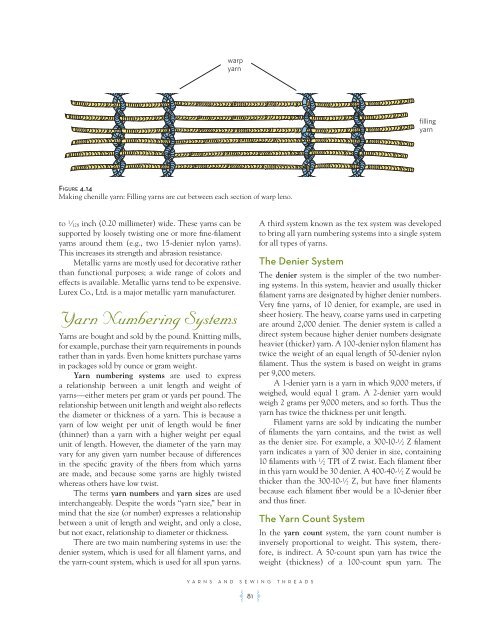You also want an ePaper? Increase the reach of your titles
YUMPU automatically turns print PDFs into web optimized ePapers that Google loves.
warp<br />
yarn<br />
Figure 4.14<br />
Making chenille yarn: Filling yarns are cut between each section of warp leno.<br />
to 1 ⁄128 inch (0.20 millimeter) wide. These yarns can be<br />
supported by loosely twisting one or more fine-filament<br />
yarns around them (e.g., two 15-denier nylon yarns).<br />
This increases its strength and abrasion resistance.<br />
Metallic yarns are mostly used for decorative rather<br />
than functional purposes; a wide range of colors and<br />
effects is available. Metallic yarns tend to be expensive.<br />
Lurex Co., Ltd. is a major metallic yarn manufacturer.<br />
Yarn Numbering Systems<br />
Yarns are bought and sold by the pound. Knitting mills,<br />
for example, purchase their yarn requirements in pounds<br />
rather than in yards. Even home knitters purchase yarns<br />
in packages sold by ounce or gram weight.<br />
Yarn numbering systems are used to express<br />
a relationship between a unit length and weight of<br />
yarns—either meters per gram or yards per pound. The<br />
relationship between unit length and weight also reflects<br />
the diameter or thickness of a yarn. This is because a<br />
yarn of low weight per unit of length would be finer<br />
(thinner) than a yarn with a higher weight per equal<br />
unit of length. However, the diameter of the yarn may<br />
vary for any given yarn number because of differences<br />
in the specific gravity of the fibers from which yarns<br />
are made, and because some yarns are highly twisted<br />
whereas others have low twist.<br />
The terms yarn numbers and yarn sizes are used<br />
interchangeably. Despite the words “yarn size,” bear in<br />
mind that the size (or number) expresses a relationship<br />
between a unit of length and weight, and only a close,<br />
but not exact, relationship to diameter or thickness.<br />
There are two main numbering systems in use: the<br />
denier system, which is used for all filament yarns, and<br />
the yarn-count system, which is used for all spun yarns.<br />
YARNS AND SEWING THREADS<br />
A 81 F<br />
filling<br />
yarn<br />
A third system known as the tex system was developed<br />
to bring all yarn numbering systems into a single system<br />
for all types of yarns.<br />
The Denier System<br />
The denier system is the simpler of the two numbering<br />
systems. In this system, heavier and usually thicker<br />
filament yarns are designated by higher denier numbers.<br />
Very fine yarns, of 10 denier, for example, are used in<br />
sheer hosiery. The heavy, coarse yarns used in carpeting<br />
are around 2,000 denier. The denier system is called a<br />
direct system because higher denier numbers designate<br />
heavier (thicker) yarn. A 100-denier nylon filament has<br />
twice the weight of an equal length of 50-denier nylon<br />
filament. Thus the system is based on weight in grams<br />
per 9,000 meters.<br />
A 1-denier yarn is a yarn in which 9,000 meters, if<br />
weighed, would equal 1 gram. A 2-denier yarn would<br />
weigh 2 grams per 9,000 meters, and so forth. Thus the<br />
yarn has twice the thickness per unit length.<br />
Filament yarns are sold by indicating the number<br />
of filaments the yarn contains, and the twist as well<br />
as the denier size. For example, a 300-10- 1 ⁄2 Z filament<br />
yarn indicates a yarn of 300 denier in size, containing<br />
10 filaments with 1 ⁄2 TPI of Z twist. Each filament fiber<br />
in this yarn would be 30 denier. A 400-40- 1 ⁄2 Z would be<br />
thicker than the 300-10- 1 ⁄2 Z, but have finer filaments<br />
because each filament fiber would be a 10-denier fiber<br />
and thus finer.<br />
The Yarn Count System<br />
In the yarn count system, the yarn count number is<br />
inversely proportional to weight. This system, therefore,<br />
is indirect. A 50-count spun yarn has twice the<br />
weight (thickness) of a 100-count spun yarn. The













